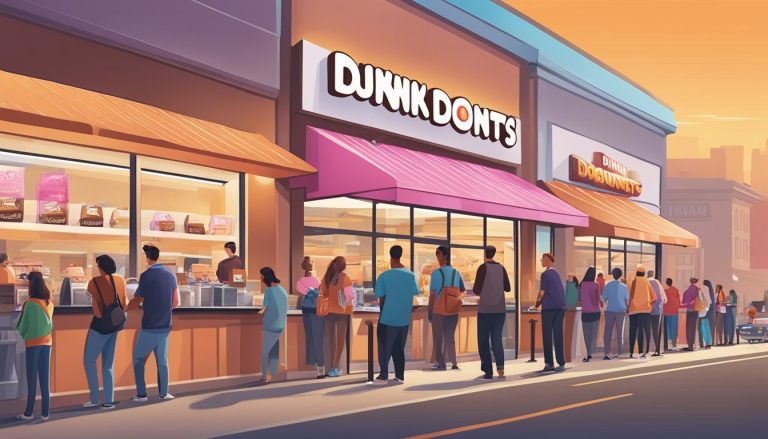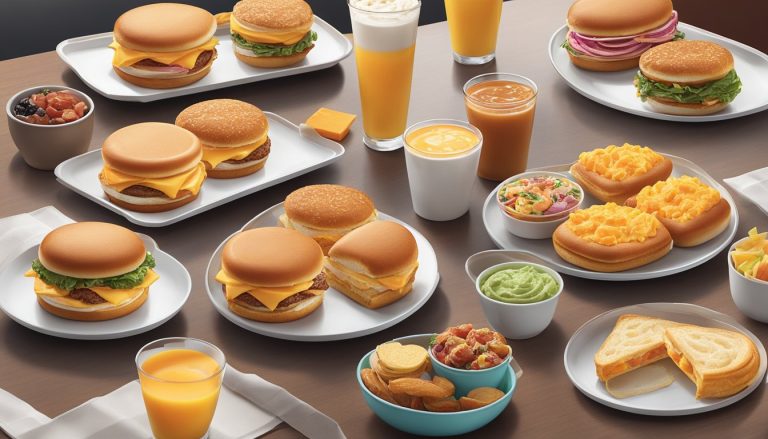Dunkin’ has long been a beloved breakfast institution in America, evoking warm memories of morning rituals and comforting treats. The brand’s success stems from its ability to tap into nostalgia while adapting to changing consumer preferences.
Nostalgia plays a significant role in Dunkin’s breakfast appeal by creating emotional connections with customers and fostering brand loyalty. The familiar orange and pink logo, the smell of fresh coffee, and the sight of donuts in the display case all trigger positive associations from past experiences. This emotional resonance keeps customers coming back, even as Dunkin’ expands its menu offerings.
While nostalgia remains a key factor in Dunkin’s appeal, the brand has also evolved to meet modern demands. The company rebranded from “Dunkin’ Donuts” to simply “Dunkin'” in 2019, reflecting its broader focus on beverages and breakfast items beyond donuts. This strategic move allows Dunkin’ to maintain its nostalgic charm while positioning itself as a contemporary breakfast destination for a new generation of customers.
The Nostalgic Connection

Dunkin’ has masterfully woven nostalgia into its brand identity, creating a powerful emotional connection with consumers. This strategy taps into cherished memories of morning routines and community gathering spots.
Emotional Branding and Consumer Loyalty
Dunkin’ leverages emotional branding to foster consumer loyalty. The brand’s familiar orange and pink color scheme evokes warm feelings associated with sunrise and fresh starts. Its longtime slogan “America Runs on Dunkin'” reinforces the idea of Dunkin’ as a daily ritual.
The aroma of freshly brewed coffee and baked goods triggers positive memories for many customers. This sensory experience is a key part of Dunkin’s nostalgic appeal.
Dunkin’s loyalty program further strengthens emotional ties. It rewards frequent visits, encouraging customers to make Dunkin’ a habitual part of their day.
The Impact of ‘America Runs on Dunkin”
The slogan “America Runs on Dunkin'” has significantly shaped brand perception. It positions Dunkin’ as an integral part of American culture and daily life.
This message resonates with consumers who see Dunkin’ as a reliable constant in their busy lives. It taps into a sense of shared experience and national identity.
The slogan has also helped Dunkin’ maintain relevance across generations. It appeals to long-time customers while attracting new ones who want to be part of this American tradition.
Dunkin’ reinforces this message through community engagement initiatives. These efforts strengthen the brand’s image as a local gathering place and supporter of American communities.
Dunkin’s Brand Evolution

Dunkin’ has undergone significant changes to its brand identity over the years. The company has balanced preserving its heritage with adapting to modern consumer preferences.
Rebranding and Revitalizing the Logo
In 2018, Dunkin’ Donuts simplified its name to just “Dunkin'”. This change aimed to emphasize the brand’s coffee offerings while maintaining a connection to its past. The iconic pink and orange colors remained, as did the familiar font introduced in 1973.
The rebranding effort extended beyond the name. Dunkin’ updated its packaging and store designs to create a more modern, streamlined look. This visual refresh helped position the brand as a beverage-led, on-the-go focused company.
Maintaining Tradition While Innovating
Dunkin’ has strategically innovated while honoring its roots. The company expanded its menu to include healthier options and specialty drinks, catering to changing consumer tastes.
Despite these changes, Dunkin’ has kept its core promise of serving quality coffee and donuts quickly. This balance has been crucial for maintaining customer loyalty while attracting new patrons.
In its global expansion efforts, Dunkin’ has adapted its offerings to local preferences. This approach allows the brand to enter new markets successfully while preserving its established identity.
Product Offerings and Customer Experience

Dunkin’ blends nostalgic favorites with modern convenience to create a diverse menu that caters to changing customer preferences. The brand’s product lineup and service innovations aim to enhance the overall experience for patrons seeking quick, satisfying breakfast options.
Diverse Menu and Healthier Options
Dunkin’ has expanded its menu beyond classic coffee and donuts to include a wide array of breakfast items. Savory options like breakfast sandwiches and wraps appeal to customers looking for heartier meals. The introduction of healthier choices, such as oatmeal and egg white sandwiches, addresses growing health-conscious trends.
Beverage offerings now include cold brew, espresso drinks, and tea alongside traditional hot coffee. Seasonal flavors and limited-time promotions keep the menu fresh and exciting. Dunkin’ also caters to dietary restrictions with non-dairy milk alternatives and gluten-free options.
Integrating Nostalgia with Modern Convenience
While maintaining its iconic donut selection, Dunkin’ has embraced technology to enhance customer experience. The Dunkin’ mobile app allows for easy ordering and payment, reducing wait times. Drive-thru service has been optimized for efficiency, catering to on-the-go customers.
In-store experiences blend nostalgic elements with modern design, creating a welcoming atmosphere. Digital menu boards and self-service kiosks offer convenience while maintaining the familiar Dunkin’ aesthetic. The DD Perks loyalty program rewards frequent customers, encouraging repeat visits and fostering brand loyalty.
Dunkin’ has successfully merged its traditional appeal with contemporary service methods, satisfying both long-time fans and new customers seeking quick, quality breakfast options.
Marketing and Customer Engagement Strategies

Dunkin’ employs diverse tactics to connect with customers and evoke nostalgia. The brand leverages digital platforms and special offers to strengthen its appeal and drive loyalty.
Harnessing the Power of Social Media
Dunkin’ utilizes social media to engage customers and reinforce its nostalgic brand image. The company maintains active profiles on platforms like Instagram, Twitter, and Facebook. These channels showcase retro-inspired content, highlighting classic menu items and vintage Dunkin’ imagery.
User-generated content plays a key role in Dunkin’s social strategy. The brand encourages customers to share their Dunkin’ memories and experiences using branded hashtags. This approach fosters a sense of community and reinforces the emotional connection many have with the brand.
Dunkin’ also leverages social media for real-time marketing. The company responds quickly to trending topics, often with a humorous or nostalgic twist that resonates with its target audience.
Leveraging Promotions and Exclusive Offers
Dunkin’ uses promotions and exclusive offers to drive customer engagement and boost sales. The DD Perks loyalty program rewards frequent customers with points and free items. This system encourages repeat visits and strengthens brand loyalty.
Seasonal promotions tap into nostalgic feelings associated with different times of year. Limited-time menu items, like pumpkin-flavored drinks in fall, create a sense of urgency and excitement among customers.
Dunkin’ also partners with other brands for exclusive collaborations. These partnerships often result in unique, limited-edition products that generate buzz and appeal to customers’ desire for novel experiences with a familiar brand.
Digital coupons and mobile app offers provide additional incentives for customers to choose Dunkin’ over competitors. These targeted promotions help the brand reach specific customer segments and drive foot traffic to stores.
Dunkin’s Position in the Coffee Shop Market

Dunkin’ has established itself as a major player in the competitive coffee shop market, known for its affordable pricing and widespread accessibility.
Competitive Landscape with Starbucks
Dunkin’ and Starbucks dominate the coffee chain landscape in the United States. While Starbucks focuses on premium offerings and a café atmosphere, Dunkin’ emphasizes quick service and value. Dunkin’ has over 12,900 locations worldwide, with about 9,500 in the U.S.
Dunkin’ targets a different customer base than Starbucks, appealing to those seeking fast, affordable coffee and breakfast options. The brand’s extensive menu includes hot and iced coffee, espresso drinks, cold brew, and a variety of food items.
To compete with Starbucks’ specialty drinks, Dunkin’ has expanded its beverage lineup. It now offers customizable options with flavors, milk alternatives, and seasonal specials.
Pricing, Accessibility, and Locations
Dunkin’s pricing strategy positions it as a more affordable option compared to Starbucks. A regular coffee at Dunkin’ typically costs 20-30% less than at Starbucks.
Accessibility is a key factor in Dunkin’s market position. The chain focuses on convenient locations in high-traffic areas, including:
- Strip malls
- Busy intersections
- Gas stations
- Airports
This strategy makes Dunkin’ easily accessible for commuters and those on-the-go. Many locations feature drive-thru service, further emphasizing convenience.
Dunkin’s market positioning revolves around speed and value. The brand’s slogan “America Runs on Dunkin'” reinforces its image as a quick, reliable option for busy consumers.
Sustainability and Corporate Responsibility

Dunkin’ has made significant strides in sustainability and corporate responsibility, focusing on responsible sourcing, environmental initiatives, and community engagement. These efforts aim to create positive impacts while maintaining the brand’s nostalgic appeal.
Investing in Sustainable Practices
Dunkin’ has committed to sourcing 100% responsibly sourced coffee by 2025. This initiative involves partnering with Enveritas, a non-profit organization dedicated to ending poverty among smallholder coffee growers. The company’s Drive-To Sustainability Program encompasses verification, partnerships, and improvement efforts.
Dunkin’ is also addressing animal welfare concerns. By the end of 2025, the company plans to convert all eggs used in U.S. menu items to cage-free sources. Additionally, Dunkin’ has pledged to source only gestation crate-free pork in the U.S. by 2022.
Packaging improvements are another focus area. Dunkin’ has been working to reduce its environmental footprint by implementing more sustainable packaging solutions across its product line.
Community Engagement and Brand Impact
Dunkin’ recognizes the importance of community involvement in maintaining its nostalgic appeal. The company has launched various initiatives to support local communities and foster positive relationships with customers.
Corporate social responsibility efforts extend to employee welfare and franchisee support. Dunkin’ has implemented programs to enhance working conditions and provide growth opportunities for its workforce.
The brand’s community engagement activities often align with its sustainability goals. This approach helps reinforce Dunkin’s commitment to responsible business practices while strengthening emotional connections with customers.
By balancing nostalgic elements with forward-thinking sustainability practices, Dunkin’ aims to maintain its appeal while addressing modern consumer concerns about corporate responsibility.
Dunkin’s Digital and Technological Shift

Dunkin’ has embraced digital technologies to enhance customer experiences and streamline operations. The brand leverages mobile apps, online ordering, and social media to meet evolving consumer preferences.
Digital Transformation of the Customer Journey
Dunkin’ revolutionized its customer journey through digital transformation. The brand introduced a user-friendly mobile app, allowing customers to browse menus, customize orders, and pay seamlessly. This digital shift reduced wait times and improved order accuracy.
In-store kiosks complement the mobile experience, offering a touchless ordering option for those without smartphones. Dunkin’ also implemented a loyalty program integrated into its digital platforms, rewarding frequent customers and encouraging repeat visits.
The brand’s online presence expanded beyond transactional features. Dunkin’ uses social media to engage customers, share promotions, and gather feedback. This two-way communication fosters brand loyalty and helps Dunkin’ stay attuned to customer preferences.
The Role of Mobile Orders and Digital Engagement
Mobile ordering became a cornerstone of Dunkin’s digital strategy. The feature allows customers to place orders in advance, skip lines, and pick up their items quickly. This convenience factor has proven particularly appealing to busy commuters and time-conscious consumers.
Dunkin’ enhanced its digital engagement through personalized offers and recommendations based on customer data. The app suggests favorite items and notifies users of nearby promotions, creating a tailored experience for each customer.
The brand also embraced contactless payment methods, including mobile wallets and tap-to-pay options. These technologies not only improve transaction speed but also address growing consumer preferences for hygienic payment alternatives.
Dunkin’s digital shift extends to its drive-thru experience. The company has tested AI-powered voice ordering systems and digital menu boards that adapt to time of day, weather, and local preferences.
Franchising and Business Growth

Dunkin’ leveraged franchising to fuel its rapid expansion across the United States and internationally. This model allowed the company to tap into local entrepreneurship while maintaining brand consistency.
Franchisee Support and Brand Consistency
Dunkin’ provides comprehensive support to its franchisees, ensuring brand uniformity across locations. The company offers extensive training programs, covering operations, product preparation, and customer service standards.
Franchisees benefit from Dunkin’s established supply chain and marketing initiatives. The company’s centralized distribution system helps maintain product quality and consistency.
To uphold brand standards, Dunkin’ conducts regular inspections and evaluations of franchise locations. This oversight helps preserve the customer experience across all stores.
Strategies for Global Expansion and Local Adaptation
Dunkin’ employs a multi-faceted approach to global expansion. The company carefully selects international markets based on factors like consumer preferences and economic conditions.
In new markets, Dunkin’ often partners with local entities familiar with regional tastes and customs. This strategy allows for menu adaptations to suit local palates while maintaining core offerings.
Dunkin’ also tailors its store designs and marketing campaigns to resonate with local cultures. This flexibility has enabled successful entries into diverse markets across Asia, Europe, and the Middle East.
The company’s international growth strategy balances brand consistency with cultural sensitivity, allowing Dunkin’ to establish a strong global presence while catering to local preferences.
Conclusion

Dunkin’ leverages nostalgia as a powerful tool in its breakfast appeal. The brand taps into customers’ fond memories of past experiences to create emotional connections.
This strategy enhances brand loyalty and customer retention. By evoking familiar flavors and atmospheres, Dunkin’ keeps patrons coming back for more.
The company’s marketing mix carefully balances nostalgia with innovation. New menu items and technologies meet evolving consumer expectations while maintaining a comforting core offering.
Digital engagement plays a crucial role in Dunkin’s nostalgic approach. Social media campaigns and mobile apps allow customers to share memories and engage with the brand in modern ways.
Strategic partnerships with other nostalgic brands further strengthen Dunkin’s appeal. These collaborations create unique, limited-time offerings that generate buzz and excitement.
Dunkin’ successfully combines the comfort of the past with the convenience of the present. This blend of nostalgia and innovation positions the brand as a reliable yet forward-thinking breakfast destination.




